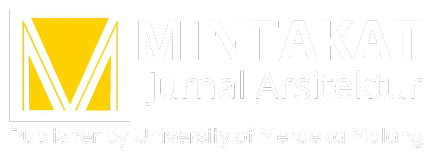EVALUASI PURNA HUNI (EPH) HOTEL SENYUM KOTA BATU PADA ASPEK TEMA “MEMORY AND ENTERTAINMENTâ€
DOI:
https://doi.org/10.26905/jam.v22i2.5570Keywords:
memory and entertainment, tema desain interior, evaluasi purna huni (EPH)Abstract
Hotel Senyum adalah salah satu fasilitas di destinasi baru di dalam lingkungan Jawa Timur Park 3, di kota Batu. Hotel Senyum mengusung konsep memory and entertainment. Konsep Hotel Senyum ini memiliki keunikan yang mengarah kepada target wisata keluarga. Setiap lantainya memiliki tema-tema yang bernuansa berbeda dan diadaptasi dari beberapa negara, antara lain seperti: Jepang, Mexico, Cina, Maroko, Afrika, Eropa, Yunani dan Indonesia, sehingga menjadikan hotel ini menjadi sangat impresif. Melalui keunikan konsep memory and entertainment tersebut tulisan ini dimaksudkan untuk mengevaluasi kesesuaian tema dengan performansi fisik interior ruangnya menurut persepsi dan pandangan wisatawan sebagai pengguna. Penelitian ini bertujuan mengetahui sukses dan tidaknya hasil konsep asil rancangan tersebut, setelah Hotel Senyum ini satu tahun beroperasi. Penelitian dilakukan dengan menggunakan metode Evaluasi Pasca Huni (EPH). Metode EPH dilakukan guna menguji secara teknis dan fungsionalnya sebuah ruangan. Secara teknis berhubungan dengan kesesuaian antara standar teknikal dengan eksisting di lapangan, sedangkan fungsional mengacu pada kesesuaian aktivitas dengan ruang didalamnya. Analisis dilakukan untuk melihat indikasi keberhasilan dari keterkaitan tema-tema didalam sebuah perancangan pada interior kamar Hotel Senyum dengan persepsi suasana menurut responden. Hasil terkait dengan jenis kelamin (gender) didominasi kategori pria prosentase senilai 70%, jumlah yang menginap dengan kategori sekali dominasi nilai prosentase 77%, berkunjung dengan keluarga didominasi nilai prosentase 87%, alasan menginap mencoba hotel baru mendominasi pada nilai prosentase 63%, tema Kamar yang paling sering dikunjungi tema kamar Maroko dan tema kamar Jepang dengan dominasi masing-masing nilai prosentase 17%, interior mencerminkan tema yang paling tinggi nilai prosentasenya 77% adalah kategori berhasil, elemen interior yang paling bagus dan memiliki paling tinggi nilai prosentasenya adalah kategori dekorasi dengan nilai 47%, alasan memilih tema kamar coba hal baru yang tertinggi memiliki nilai prosentase 70%, tingkat kepuasan dengan nilai prosentase 80% adalah kategori puas.
Â
Kata kunci : memory and entertainment, tema desain interior, evaluasi purna huni (EPH)
Â
ABSTRACT
Hotel Senyum is one of the facilities in a new destination within the Jawa Timur Park 3 neighborhood, in the city of Batu. Hotel Smile carries the concept of memory and entertainment. The concept of this Hotel Senyum is unique which leads to family tourism targets. Each floor has different nuanced themes adapted from several countries, such as: Japan, Mexico, China, Morocco, Africa, Europe, Greece and Indonesia, making this hotel very impressive. Through the uniqueness of the concept of memory and entertainment, this paper is intended to evaluate the suitability of the theme with the physical performance of the interior of the space according to the perceptions and views of tourists as users. This study aims to determine the success or failure of the results of the original design concept, after the Hotel Senyum has been operating for one year. The study was conducted using the Post-Occupational Evaluation (EPH) method. The EPH method is used to test technically and functionally a room. Technically related to the suitability of technical standards with existing in the field, while functional refers to the suitability of the activity with the space in it. The analysis was carried out to see indications of the success of the interrelationship of themes in a design on the interior of the Hotel Senyum room with the perception of the atmosphere according to the respondent. The results related to gender are dominated by the male category, the percentage is 70%, the number who stays in the single category is the percentage value is 77%. The rooms most frequently visited are Moroccan theme rooms and Japanese room themes with a dominance of 17% each, the interior reflects the theme with the highest percentage value 77% is the successful category, the best interior element and has the highest percentage value is the decoration category with a value of 47%, the reason for choosing the theme of the room to try new things is the highest percentage value of 70%, the level of satisfaction with a percentage value of 80% is the satisfied category.
Â
Keywords: memory and entertainment, interior design themes, after-occupancy evaluation (EPH
Downloads
References
Becker, F. (1989). Post-Occupancy Evaluation: Research Paradigm or Diagnostic Tool. In W. F. E. Preiser (Ed.), Building Evaluation (pp. 127–134). Springer US. https://doi.org/10.1007/978-1-4899-3722-3_10Ching, F.D.K. (1996). Ilustrasi Desain Interior. Jakarta: Erlangga.
Ching, F.D.K. (2002). Architecture, Space and Order. New York: Maxmillan Publishing Company.
Choi, J.-H., & Lee, K. (2018). Investigation of the feasibility of POE methodology for a modern commercial office building. https://doi.org/10.1016/J.BUILDENV.2018.07.049
Hartman, T. (1987). The Color Code. California.
Lawson, F. (1988). Hotels & Resorts Planning, Design and Refurbishment. Oxford: Butterworth Architecture.
Nurhayati. (2004). Penataan Tanaman di Rumah Tinggal. Jakarta: Gramedia.
Preiser, W.F.E. (1989). Building Evaluation. New York: Plenum Press.
Sanni-Anibire, M. O., Hassanain, M., & Al-Hammad, A.-M. (2016). Post-Occupancy Evaluation of Housing Facilities: Overview and Summary of Methods. Undefined. https://www.semanticscholar.org/paper/Investigation-of-the-feasibility-of-POE-methodology-Choi-Lee/4bc49908ffae180a00d7d19341da2411f76e59af
Setiawan, B. dan Haryadi. (2010). Arsitektur, Lingkungan dan Perilaku. Yogyakarta: Gadjah Mada University Press.
Snyder, J.C., dan Catanese, A.J., (1988). Pengantar Arsitektur. Jakarta: Erlangga.
Sudibyo, S. (1989). Aspek Fungsi dan Teknik Post Occupancy Evaluation dan Beberapa Metodologi Penelitian. Dalam Seminar Pengembangan Metodologi Post Occupancy Evaluation. Jakarta: Trisakti.
Sulastiyono, A. (1999). Manajemen Penyelenggaraan Hotel. Bandung: Alfabeta.
Suptandar, J.P. (1991). Desain Interior: Pengantar Merencana Interior untuk Mahasiswa Desain dan Arsitektur. Jakarta: Djambatan.













